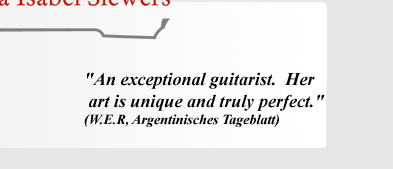 |
 |
 |
 |
 |
 |
 |
 |
| CANCIONES DE CUNA |
|||
| Español
|
NOTES ASTOR PIAZZOLLA HISTOIRE DU TANGO RAFAEL GINTOLI, violin MARIA ISABEL SIEWERS, guitar Enchanted by a performance of the Elvino Vardaro Tango Sextet in Mar del Plata during his adolescence, Astor Piazzolla left the city of his birth to settle in Buenos Aires and, at the age of eighteen, fulfilled one of his dreams by playing the bandoneon in Aníbal Troilo's orchestra. Later he also arranged pieces for this ensemble. At the same time, he also took composition lessons with Alberto Ginastera. Piazzolla left Troilo's Orchestra in 1944, but kept up a lifelong friendship with the great tango musician. He began to compose "classical" music and founded the Orquesta del 46. In 1951, Piazzolla was awarded the Fabien Sevitzky Prize for his Tres Movimientos Sinfónicos Buenos Aires, which included bandoneons in the instrumental line-up. The premiere in Buenos Aires in 1953 elicited indignation from some members of the audience. The prize included a grant to study in Paris with Nadia Boulanger. The great composer and pedagogue helped Piazzolla to overcome the crisis that had kept him away from tango since the 1950s. In addition to teaching him composition, she also instilled the valuable lesson of objectivity and gave him the tools to resolve his dilemma of "either classical music or tango". She suggested that, instead of only playing his exercises on the piano, he should perform for her a piece from the repertoire he used to play on his bandoneon. After listening to Piazzolla's tango Triunfal, Boulanger encouraged him to try to write his own kind of music. Some of Nadia Boulanger's own music later included tangos. Piazzolla seems to have been reconciled with the tango from then on, but did not return to his former style. As Carlos Kuri said in his book "Piazzolla, la música límite" ("Piazzolla, extreme music"): "Piazzolla transcends the clearly defined borders between many kinds of music by weaving them into one." After a short sojourn in Buenos Aires, Piazzolla returned to New York, the city where he had lived during his childhood with the aim of composing film music for Hollywood. On being unable to realise this plan, he founded the Quintet J-T, a jazz tango ensemble. When this group was coolly received, however, he made the wise decision to return to South America. In Buenos Aires, with the support of excellent classical, jazz, and tango musicians, he continued what he had begun in New York, and this time he was successful. Eclectic composers rarely possess Piazzolla's ability to absorb and achieve a convincing synthesis of a wide range of influences. In Piazzolla's music, however, these influences work in synergy—the whole is greater than the sum of its stylistic parts, and it is immediately recognizable. According to Kuri, it is "unprecedented music, a ground-breaking thrust that achieves a fitting blend of heterogeneous sonorities". Piazzolla focused his attention on the tango with a single-mindedness paralleled only by Domenico Scarlatti or Ludwig van Beethoven in their keyboard sonatas, which stretch a single musical form or genre beyond its established (or imagined) limits of form and expressivity. In this way, tango became established as a serious form and a flexible musical genre. John Duarte, the British guitarist and reviewer, wrote: "A notice in the ballroom of a first class hotel in Africa once read: 'Ladies and gentlemen are requested not to dance too closely together, as this excites the baser passions'—a caveat that is emphasised by the intimate attitude and movements of the tango. When the tango first emerged, it was regarded as an erotic dance whose natural 'home' was the bordel (brothel), as was jazz in its early years. In these more relaxed times, eroticism is not so sternly disapproved. Tango lessons and ÔmilongasÕ are now popular—and not only in Argentina." The first movement of Histoire du tango is titled Bordel 1900. The subsequent movements, Café 1930, Nightclub 1960, and Concert d'aujourd'hui, also describe the places where tango circulated in those times and illustrate their characteristics through the music. Though originally written for flute and guitar, Histoire du tango is often played with violin, an instrument that has a prominent role in tango ensembles. Attracted by the sound of the classical guitar, Piazzolla composed his first work for this instrument in 1980, Cinco Piezas para guitarra, consisting of the movements Campero, Romántico, Acentuado, Tristón and Compadre. Three more works for guitar followed, but all these are chamber music or works for guitar and orchestra: Tango Suite for guitar duo (1983), the above mentioned Histoire du Tango pour flûte et guitare (1985) and the Double Concerto pour guitare, bandoneón et orchestre àcordes (1985). In her article "Cinco Piezas para guitarra de Astor Piazzolla. Las cuerdas entre el campo y la ciudad" Sivia Glocer, the Argentine musicologist, writes that, through this piece, Piazzolla is able to complete a :"return journey" between the opposing poles of countryside and city, generating a certain aesthetic that allows him to address the subject of the Argentine national identity from a new perspective. Campero ( meaning "of the countryside") is a milonga sureña, related to the countryside, dedicated to his father. Romántico honors its name through its gentle melodic beauty and rich harmonies. Acentuado and Compadre are related to the urban music of Buenos Aires. There is more tension and violence here, and the percussions and cadences reminiscent of Piazzolla's improvisation on the bandoneon bring us closer to tango. Compadre refers to the gaucho, a figure from the Argentine countryside, who, when moving to the city, loses part of his cultural identity and values and becomes a quarrelsome and arrogant personality. Tristón ("with intimate sadness") is a funeral march which Piazzolla composed after watching a documentary about the consequences of the civil war in Nigeria at the end of the 1970s. It is a tribute to the children who died during the Nigerian Civil War. The remaining pieces on the CD are arrangements. Escualo recalls Piazzolla's fishing holidays in Punta del Este, Uruguay, and his excitement when catching an escualo, a species of shark. The work was written for the violinist Fernando Suarez Paz, who, when he joined the Quintet, already had experience in classical music, jazz, and tango. Piazzolla demanded high-level performances and had an acid sense of humor; it is said that he put the score of Escualo on Paz's music stand at a concert and said: "Let's see if you can play this!" It is a very demanding piece for the violinist with a fast candombe rhythm (4/4 with accents on the first, fourth and seventh quavers). Chiquilín de Bachín, arranged for guitar solo by Cacho Tirao, an extraordinary Argentine guitarist who performed in one of Piazzolla's Quintets, is a portrait of a homeless child on the streets of Buenos Aires. It was originally written for voice (the lyrics are by Horacio Ferrer, an Argentine poet who wrote the texts for many of Piazzolla's songs). Soledad (a milonga nocturna) conveys Piazzolla's sadness during a difficult time in his life. This too was originally written for his Quintet. Chau Paris (Chau is lunfardo, Buenos Aires slang, for "bye-bye") was written in 1955, during the time of Piazzolla's study with Nadia Boulanger. It might now be interpreted as a farewell, since although he died in Buenos Aires, his death in 1992 was a direct consequence of the stroke he suffered in Paris in 1990. Milonga en re was originally written for violin and piano and dedicated to one of his friends, the famous Italian violinist Salvatore Accardo. Valsísimo, originally for piano, is a kind of Brazilian Valsa with harmonic overtones of jazz. Piazzolla was fond of using exaggerated superlatives, as also in Contrabajísimo and Guitarrisimo. His own character, too, is best described in terms of superlatives as "Piazzollisimo"! María Isabel Siewers Translation: Eva-Raphaela Jacksh Rafael Gintoli Violin He studied under Emilio Pelaia, Humberto Carfi and Szymsia Bajour. In 1968 he won the City of Buenos Aires Municipal Prize and in 1972 he received a scholarship to pursue higher studies in Holland which was awarded jointly by the ÒMozarteum ArgentinoÓ and the Dutch Ministry of Science, Culture and Education in The Hague. From the early age of 16 he performed as a soloist with the most renowned orchestras in Argentina, South America and Europe. Amongst them the Buenos Aires Philharmonic, the Bari Symphony in Italy, Camerata Bariloche (Argentina), S‹o Paulo Symphony (Brazil) and Hamburg's Das Neue Werk Ensemble. He has recorded for RAI (Italian Radio and TV), Radio Bern, Radio Maastricht (Holland), TV Globo (Brazil) and for the Islandic National Broadcasting System. During 1998 he recorded Alicia Terzian's Violin Concerto with the ZŸrich Symphony Orchestra for the label D.O.M. Rafael Gintoli was appointed leader and first violin at Teatro Massimo in Palermo, Teatro La Fenice in Venice, the Haydn Orchestra in Bolzano, the Sinfonietta belonging to the Teatro Lirico di Cagliari and the Rome Sinfonietta. During his career he has been distinguished with the Critics' Association Award for the Best Argentine Performer (1999) and he also received the Lifetime Achievement Award from the Argentine Accademy of Music. In 2000, he won the "Estirpe" Prize for classical music. In 2003, with Paula Peluso, he received the award for Best Argentine Chamber Ensemble; four years later, he was the recipient of the Outstanding Personality Award in the Arts, bestowed by the Office of the Mayor of the City of Buenos Aires. Rafael Gintoli was Artistic Director and member of the Jury at the International Violin Competition Buenos Aires 2010 and 2012 and has adjudicated in the International Violin Competitions "Luis Sigall" (Chile) and "Rodolfo Lipizer" (Gorizia, Italy). He has been invited to perform for the Festival Cervantino in Mexico, and for festivals in Taiwan, Spain and, together with Martha Argerich, at the Teatro Colón in Buenos Aires and at the Auditorio Santa Cecilia in Rome. María Isabel Siewers Classical Guitar Acclaimed for her extraordinary lyricism, refined artistic temperament and outstanding technique, Maria Isabel Siewers has performed in many of the greatest halls, including the Wigmore Hall (London), Konzerthaus (Vienna), Martinu Hall (Prague), Carnegie Hall (New York) and the Théatre des Champs Elysées (Paris), and has played in many important music festivals. She has regularly toured, taught and adjudicated in international competitions throughout Europe, North and South America, Singapore, Malaysia, Australia and New Zealand. She has occupied several teaching posts in Argentina and, since 1989, she has been head of a guitar department in the University of Arts Mozarteum in Salzburg, Austria. She has appeared as a soloist with, amongst others, the Argentine National Symphony Orchestra, the Prague Virtuosi, the Radio/TV Orchestra of Zagreb, the Bohemian Chamber Orchestra, the National Orchestra of Cuba, Orchestra of the University of Auckland, the Cracow Philharmonic Orchestra, the University of Cuyo Orchestra, Mendoza Philharmonic Orchestra, Quattro Orchestra Prag and the Chamber Orchestras of Mayo and Morón (Argentina). Ms Siewers'recordings have received many awards, including "Critic's choice" (Gramophone)for her Guastavino recording and "Best record of the year" (Acoustic Guitar) for Maximo Pujol, Guitar and Chamber Music. In seeking to expand the repertoire of the guitar she has premiered numerous solo and chamber works and concertos. She premiered the Concierto de Estio, written for her by Sylvie Bodorova, in 2000. Other eminent composers have dedicated works to her: Simone Fontanelli, José Luis Campana, Jorge Cardoso, John Duarte, Gustavo Kantor, Máximo Diego Pujol, Larry Traiger, Marios Joannou Elias, and Sergio Parotti. Maria Isabel Siewers studied in her native Argentina with Maria Luisa Anido and at the Manuel de Falla Conservatory, finally receiving a Gold Medal. She participated in masterclasses with Andrés Segovia in Santiago de Compostela, and at the Accademia Chigiana in Siena. Later she studied with Abel Carlevaro and Nikolaus Harnoncourt. In 2009 the Municipality of Templin, Germany, named Isabel Citizen of Honour as a symbol of gratitude for her long support to the cultural life of that city. The same year she was awarded the "Konex Prize" in the category "Music" for her achievements in this field during the last decade. From 2011 to 2014 Isabel Siewers performed, offered masterclasses, and adjudicated in international competitions in Singapore, Australia, New Zealand, Malaysia, Argentina, Italy, Austria, Germany, and Spain. Production: María Isabel Siewers and John Taylor Recording : John Taylor Recorded at Holy Trinity Church, Weson, Herts, 7-9 Febuary 2000 and 2-3 October 2000. Isabel Siewers plays a Greg Smallman guitar (Australia, 1991) Rafael Gintoli plays a Paul Kaul violin (Cannes, France, 1923) More information in:: |
|
|
|
|||
|
|
|||